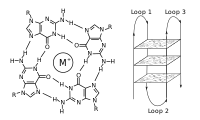
Photo from wikipedia
Abstract Owing to their chiral and self-assembly features, chiral supramolecules exhibit superior recognition and catalytic abilities. Here, we construct a chiral H-aggregates based on a cyanine dye, 3,3′-di(3-sulfopropyl)-4,5,4′5′-dibenzo-9-methyl-thiacarbocyanine triethylammonium salt… Click to show full abstract
Abstract Owing to their chiral and self-assembly features, chiral supramolecules exhibit superior recognition and catalytic abilities. Here, we construct a chiral H-aggregates based on a cyanine dye, 3,3′-di(3-sulfopropyl)-4,5,4′5′-dibenzo-9-methyl-thiacarbocyanine triethylammonium salt (MeCy), by spontaneous symmetry breaking in the presence of NaNO3. The chiral H-aggregates could specially recognize parallel DNA G-quadruplexes among other DNA types, probably by a three-step process, which comprises the amplified chiral induction, the disassembly of chiral H-aggregates and the binding of the MeCy monomer. The MeCy monomer binding to DNA parallel G-quadruplex led to a lighting-up fluorescence intensity obviously. Chiral supramolecules targeted to DNA G-quadruplex was proposed, and its transformation process was revealed, and thus potentially provided an excellent probe for DNA parallel G-quadruplexes.
Journal Title: Dyes and Pigments
Year Published: 2021
Link to full text (if available)
Share on Social Media: Sign Up to like & get
recommendations!